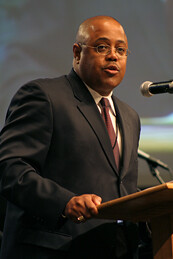
New district alignment strengthens city ministries
UMConnection Staff
 In an initiative aimed at better allocating conference resources to help all churches become Acts 2 congregations, the members of the Baltimore-Washington Conference overwhelmingly passed a proposal to move from nine districts to eight, but not reduce the number of Guide staff.
In an initiative aimed at better allocating conference resources to help all churches become Acts 2 congregations, the members of the Baltimore-Washington Conference overwhelmingly passed a proposal to move from nine districts to eight, but not reduce the number of Guide staff.
The change in alignment places an emphasis on guiding and supporting pastors and congregations rather than administrating and managing the ministry of pastors and congregations. The plan will go into effect July 1.
The new district alignment will give the conference's four regions approximately an equal number of churches, and will allow districts to determine what will be the best fit for them in terms of needs, geography and shared ministry.
The maps of the new districts and the church listings, according to district, are now available. According to the Book of Discipline, annual conference members set the number of districts, the Cabinet sets the boundaries.
Another option considered was moving from nine to 10 districts, but that would have created more administration, which would have resulted in more staff and salary added to the conference budget.
"We wanted to address capacity issues and relationship building issues without increasing the conference budget," said the Rev. T.R. Chattin, the regional director of the Western Region and chair of the alignment committee. "We think this plan is fair, equitable and addresses many needs."
Each region will be staffed by two district superintendents, three additional Guide staff and two administrative staff. The conference will save approximately $250,000 a year and $1 million over the quadrennium with the new alignment.
This savings helped to reduce the benevolence factor, the rate churches are apportioned, by another half a percent while improving the conference's work with local churches, conference leaders said.
"This plan assures the greatest impact in terms of building relationships and guiding and resourcing our churches," Chattin said. "And there is a cost savings. We were going to employ two additional Guides to meet our capacity needs. But now we can go with 20 Guides and one less administrative assistant."
One of the major concerns raised was the economic and racial diversity of the new Baltimore Metropolitan District. But the breakdown of this new district will be the most diverse in the conference, as there will be 53 white churches, 30 African-American churches, one Hispanic church and one Asian church.
The Rev. C. Anthony Hunt, superintendent of Baltimore-Harford District, said that the new alignment will strengthen the conference's Hope for the City initative, which Hunt chairs.
The plan includes a 10-point strategy that will create a more effective presence of conference churches in Baltimore City. He said that the new realignment plan will place Baltimore churches in the same district, allowing for greater collaboration. The new district will be called Baltimore Metropolitan.
"I come to proclaim that there is hope for the city," Hunt said. "[Realignment] will allow churches in the city to work closer together to strengthen leadership in our churches and communities, and start new congregations."
A substitute motion to move from nine districts to 10 was defeated.
Baltimore City pastors voiced their favor of the move.
Rev. Emora Brannan, pastor of Grace UMC in Baltimore, said the proposal to move to eight districts and grouping the city churches together will remove the barrier of pastors getting to know each other better in the city.
"Having the [city] churches spread over three districts has been an impediment," Brannan said. "This will allow pastors to get to know each other and collaborate more."

Login/Register to leave comment